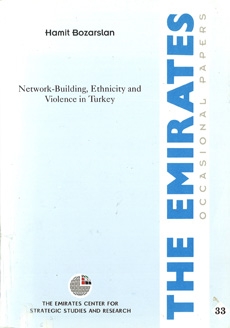|
INTRODUCTION
In November 1996, near the Turkish town of Susurluk, in a banal car accident, a Mercedes going at 180 kilometers per hour crashed into a truck. Three of its passengers died instantly: Abdullah Çatli, a well-known radical-right militant sought by Interpol for 18 years for his involvement in more than a dozen homicides; Gonca Us, his second wife to whom he had been wed only in a religious ceremony;' and Hüseyin Kocadag, a high ranking member of the Istanbul police.2 The only survivor was Sedat Bucak, a Kurdish tribe leader with very close ties to former Turkish Prime Minister Tansu Çiller, and a deputy of her party. The car was full of sophisticated unlicensed weapons.
The testimonies and press reports on the passengers of the crashed Mercedes revealed that they were in fact part of a “gang” (çete), comprised of members of the security forces, politicians and radical-right militants. They also emphasized that the gang, baptized the Susurluk Gang after the accident, was only one of the nine Uniformed Gangs (Uniformali Çeteler) operating in Turkey.3 In many cases, the gangs were manipulated by one of the state’s coercive organs; but in turn, they also used the state for logistical support and as an immunity shield for their autonomous activities. The public in Turkey was shocked.4
Although almost no juridical action has been taken against the gangs hundreds of living members, the testimonies submitted to an ad hoc Parliamentary Inquiry Commission and two official reports prepared respectively by this Commission and by Kutlu Savas, an inspector charged by Prime Minister Mesut Yilmaz to investigate the allegations, brought quantities of evidence on the links between radical right-wing militants, the state and Mafiosi groups. They have also shown how during the 1990s, the radical-right militants were used by the state as death squadrons.
As far as social scientists are concerned, these rich data have prompted many new perspectives on the comprehension of Turkish political life and the state coercion and civil violence which have dominated it for the past two decades. They also allow a better understanding of the Turkish policy-making processes as well as the structuring of Turkish political life at different levels (local, nation-wide, regional and international). Finally, they shed new light on the country’s ethnic relations, disclosing the link between ethnicity and violence while revealing the limits of ethnicity as the sole criterion of network-building or policy-making.
Among many research directions suggested by these new data, I will explore two, developed in the final section of this paper. The first concerns state and power relations in Turkey and in many Middle Eastern countries. While admitting fully, that state-coercion remains efficient in the management of social issues, I will argue that state-based sociology is of mediocre utility in explaining Middle Eastern societies. Furthermore, I will suggest that in understanding the Middle East, the research should move from the analysis of the state towards that of power structures and relations. The second research direction concerns the network-building process as a constant production and reconstruction of modem, nation-wide power structures and relations in Turkey. The analysis of the formation and in some cases, the decline of solidarity networks, their transformation and their reactivation constitutes, to some extent, the focus of such political processes and phenomena as state coercion and civil violence as well as ethnic relations.
In order to understand these power structures and these network-building processes, I will use, among many personal and collective biographies which could have been significant, only three. This methodological choice is partly imposed by the material impossibility of taking into account the Uniformed Gangs in their entire complexity; they count hundreds of members and they have operated for more than two decades. No investigator has been able to give a coherent and complete inquiry of their activities and links in Turkey and abroad.5 Challenged by the quantity of information with which to deal, researchers need a tool that would enable them to understand this phenomenon by some degree of simplification. Biography is one of those instruments. Using biographical notes allows an understanding, through personal stories, of different patterns of group constructions, political action and social structuring.
The first biography I will present in three distinct phases, is that of Abdullah Çatli, the most famous member of the Susurluk Gang, although far from being its most powerful element. His network is the product both of an ideological commitment to the radical-right and of a primary and secondary socialization first as a teenager in an Anatolian province, and later in Ankara and Istanbul during the 1970s. The network grew through new links both in Turkey (with state organs and Mafia groups) and abroad (contacts with the Italian Gladio).
The second biography is that of Sedat Bucak. The origins of Bucak’s network are to be found in a blood solidarity or tribal asabiyya, to use a key concept of Ibn Khaldun, and in the clientelization of other tribes. Under the leadership of Sedat, the Bucaks, a small tribe of some 20,000 people, were able to found a private army of some 10,000 men. The tribal solidarity link was successfully used to build a nation-wide patron-client relations web, allowing the Bucaks to play a large role in the allocation of military and economic resources. In this web, the Bucaks were both patrons and clients.
The final, brief biography is that of Behçet Cantürk (assassinated in Istanbul by the Susurluk Gang in 1993). His network, although much less structured than the two others, was based on a Kurdish ethnic solidarity, with some Armenian affinities as well as a specific “godfather’s ethos,” combining bravery and generosity. Cantürk and other Kurdish “godfathers” were proud of their affiliation and their financial support to Kurdish nationalist organizations. However, in order to succeed, they also had to build bridges with some groups and key men within the state (such as the military general Sahinkaya or Sükrü Balci, chief of the Istanbul police).
.....
|
